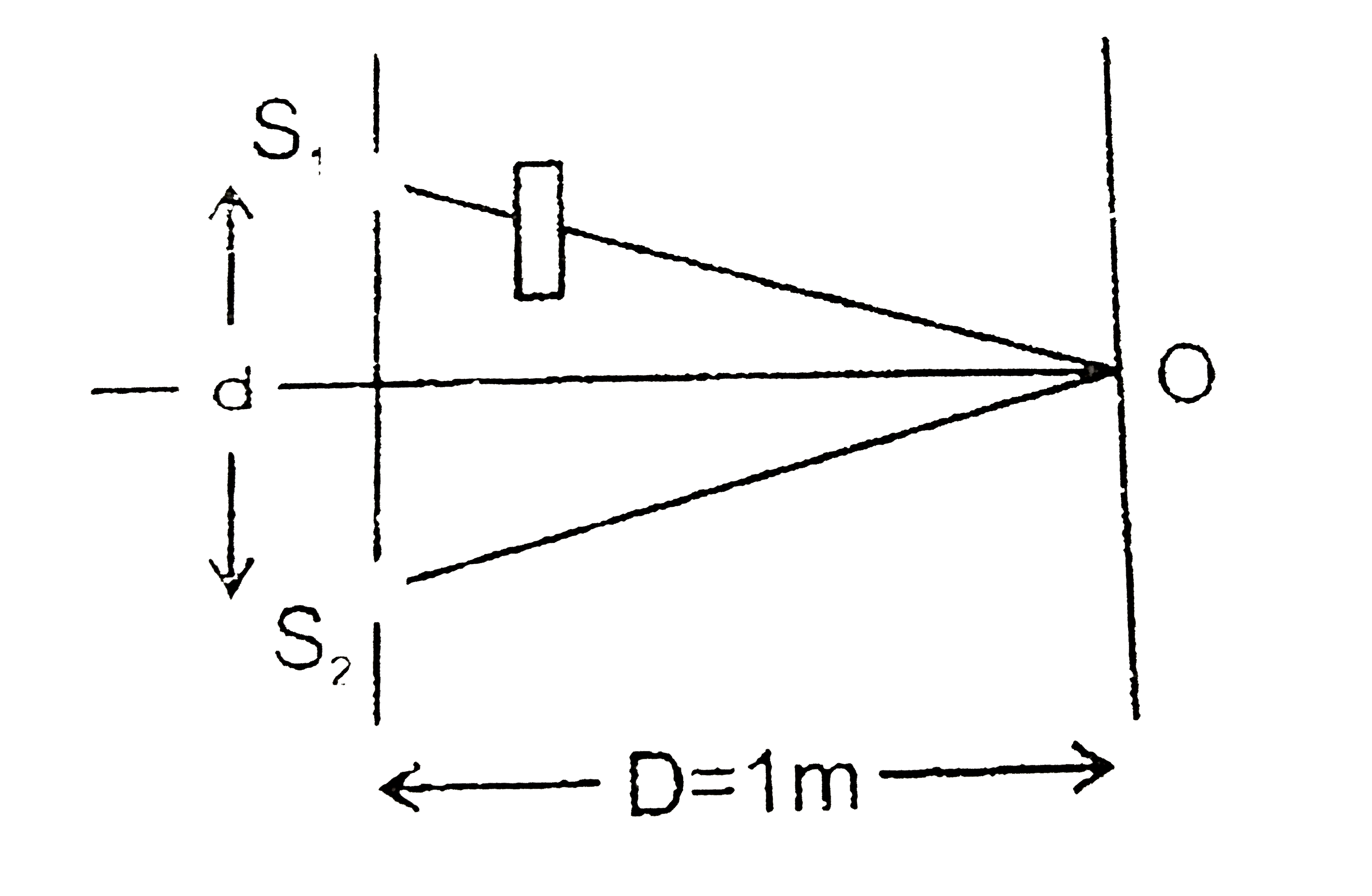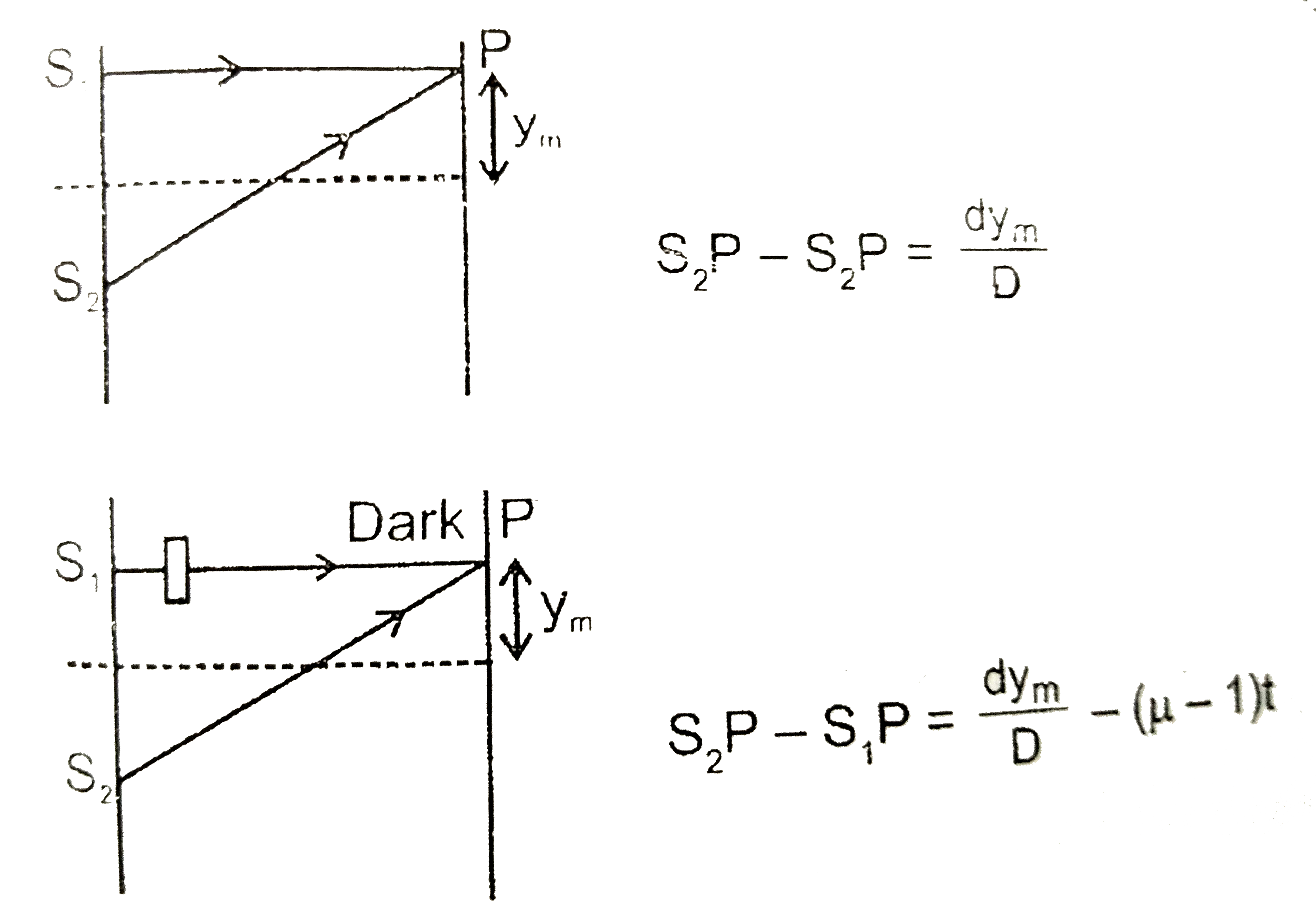A monochromatic light of λ=500nm is incident on two identical slits separated by a distance of 5×10−4m. The interference pattern is seen on a screen placed at a distance of 1m from the plane of slits. A thin glass plate of thickness 1.5×10−6m and refractive index μ=1.5 is placed between one of the slits and the screen. Find the intensity at the centre of the screen if the intensity is I0 in the absence of the plate. Also find the lateral shift of the central maxima and number of fringes crossed through centre.
The correct Answer is:0,1.5mm
 After the thin plate is placed between one of the slits and the screen, an additional path difference [ΔP=(μ−1)t] is created between the rays emerging out of S1andS2. Thus
After the thin plate is placed between one of the slits and the screen, an additional path difference [ΔP=(μ−1)t] is created between the rays emerging out of S1andS2. Thus
S1O−S2O=(μ−1)t=0.75×10−6m
(μ−1)tλ=32⇒(μ−1)t=32λ
Point O would be an interference minimum. Thus intensity at O is zero.

S1P−S2P=dymD
S2P−S1P=dymD−(μ−1)t
For central maxima, the path difference between the interfering beams is zero.
i.e.S2P−S1P=0
⇒dymD=(μ−1)t⇒ym=Dd(μ−1)t=15×10−4×0.75×10−6=1.5mm
Thus, the effect of putting a thin film in front of one of the slits is to shift the central maxima towards that alit.
Topper's Solved these Questions
Similar Questions
A monochromatic light of λ=500Å is incident on two identical slits separated by a distance of 5×10−4 m. The interference pattern is seen on a screen placed at a distance of 1 m from the plane of slits. A thin glass plate of thickness 1.5×10−6 m and refractive index μ=1.5 is placed between one of the slits and the screen . Find the intensity at the center of the screen.
View SolutionMonochromatic light of lamba=5000Å is incident on two slits separately by a distance of 5×10−4m. The interference patteren is seen on a screen placed at a distance of 1m form the slits. A thing glass plate of thicknes 1.5×10−6m and refractive index μ=1.5 is placed between one of the slits and the screen. Find the intensity at the centre of the screen if the density there is I0 in the absence of the plate. Also find the lateral shift of the central maximum. '
View Solution
Knowledge Check
A monochromatic light of λ=5000Å is inciden on two slits seperated by a distance of 5×10−4m. if a thin glass of thickness 1.5×10−6 m and refractive index 1.5 placed between one of the slits and screen. The pahses difference introduced at the position of central maxima is
A3πB2πC2π/3Dπ/3A thin glass plate of thickness t(=λ/3,λ being the wavelength of incident light ) and refractive index μ=1.5 is inserted between one of the slits and the screen in Young's double slit experiment. If the intensity at a point on the screen equidistance from the slit is i, then
Aintensity at the same point before introduction of glass plate was 31/2Bintensity at the same point before introduction of glass plate was 41/3Ccentral maximum will be in the lower half of screen after introduction of glass plateDshape of fringes will be straight line on the screenA plane monochromatic light falls normally on a diaphragm with two narrow slits separated by a distance d = 2.5 mm. A fringe pattern is formed on the screen placed at D = 100 cm behind the diaphragm. If one of the slits is covered by a glass plate of thickness 10μm, then distance by which these fringes will be shifted will be :
A2 mmB3 mmC4 mmD5 mm
A thin glass plate of thickness t and refractive index μ is inserted between screen and one of the slits in a young's experiment. If the intensity at the centre of the screen is I, what was the intensity at the same point prior to the introduction of the sheet.
View SolutionTwo slits in YDSE are placed 1 mm from each other. Interference pattern is observed on a screen placed 1m from the plane of slits. What is the angular fringe width for a light of wavelength 400 nm
View SolutionLight of wavelength 5000×10−10m is incident normally pattern is observed to lie at distance of 5 mm from the central maximum on screen place at a distance of 3 from the slit. Then the width of the slits is
View SolutionA thin glass plate of thickness is 25003λ (λ is wavelength of light used) and refractive index μ=1.5 is inserted between one of the slits and the screen in Young's double slit experiment. At a point on the screen equidistant from the slits, the ratio of the intensities before and after the introduction of the glass plate is :
View SolutionIn Young's double slit experiment, the slits are 0.5mm apart and interference pattern is observed on a screen placed at a distance of 1.0m from the plane containg the slits. If wavelength of the incident light is 6000Å, then the separation between the third bright fringe and the central maxima is
View Solution

